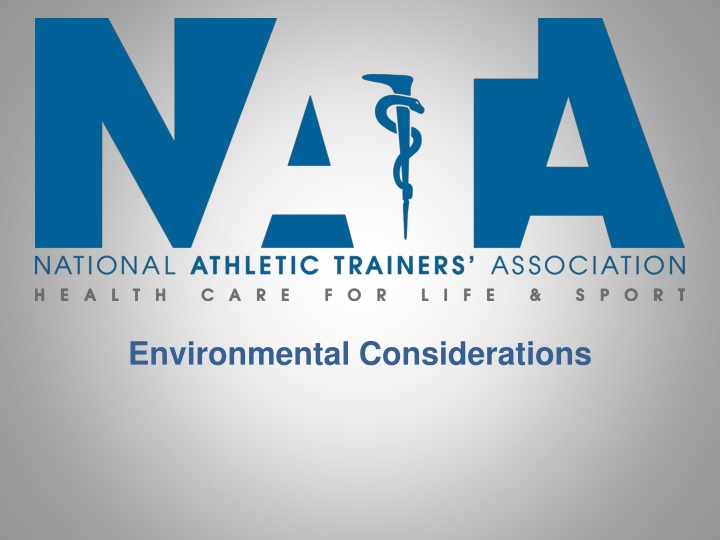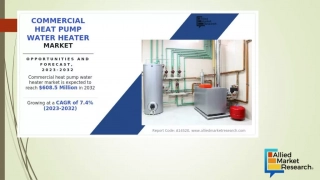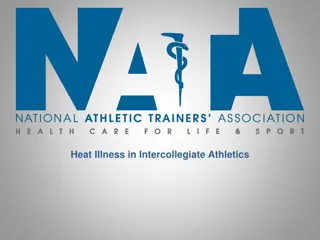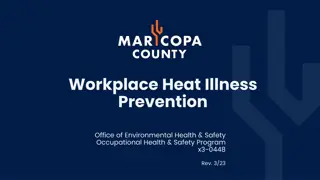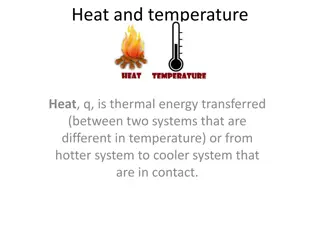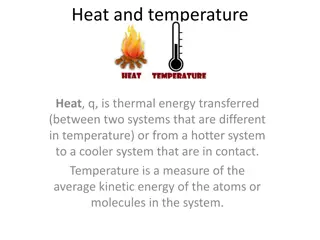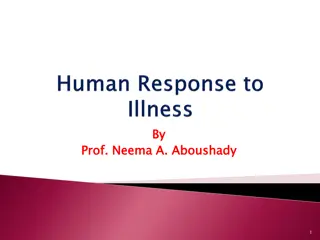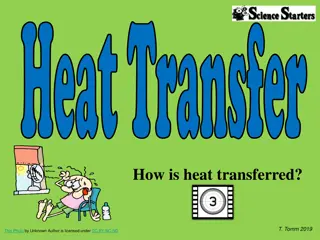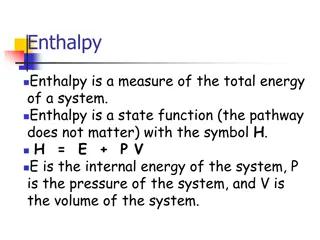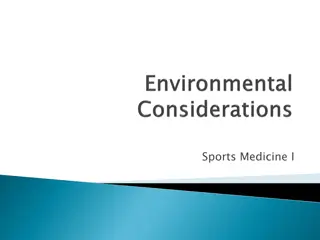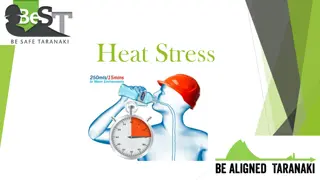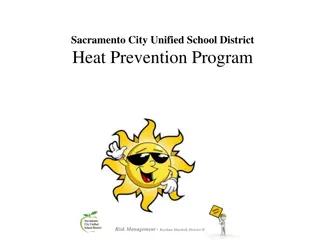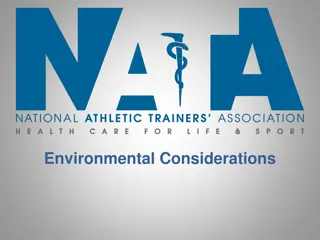Environmental Considerations and Heat Illness Recognition & Treatment
Recommendations for exercising in different environments such as hot, humid, and cold, along with protocols for recognizing, treating, and preventing heat-related illnesses like heat stroke and exhaustion. Includes guidelines for acclimatization, heat index usage, wind chill factor, lightning safety, and athlete prevention recommendations.
Download Presentation

Please find below an Image/Link to download the presentation.
The content on the website is provided AS IS for your information and personal use only. It may not be sold, licensed, or shared on other websites without obtaining consent from the author.If you encounter any issues during the download, it is possible that the publisher has removed the file from their server.
You are allowed to download the files provided on this website for personal or commercial use, subject to the condition that they are used lawfully. All files are the property of their respective owners.
The content on the website is provided AS IS for your information and personal use only. It may not be sold, licensed, or shared on other websites without obtaining consent from the author.
E N D
Presentation Transcript
Environmental Considerations Included are recommendations for: Exercising in hot and humid environments Recognition, treatment and prevention of heat related illnesses Acclimatization recommendations Heat index and usage Exercising in cold environments environments Recognition and prevention of cold-related injuries Wind chill factor table and usage Lightning safety and protocols
Recognition of Heat Illnesses Suspect Exertional Heat Stroke if any of these signs or symptoms are present during or immediately after exercising in hot conditions: Disorientation, confusion, dizziness, vomiting, diarrhea, loss of balance, staggering, irritability, irrational or unusual behavior, apathy, aggressiveness, hysteria, delirium, collapse, loss of consciousness, and coma OR Core body temperature of greater than 104o taken via rectal thermometer soon after collapse. Other temperature devices should not be relied upon and have not been proven accurate on persons with exertional heat stroke. Initiate immediate cooling procedures and call 9-1-1 if these are present. Suspect Heat Exhaustion and seek medical attention (call AT) if any of these signs or symptoms are present during or after activity: cool clammy skin, disorientation, confusion, emotional instability, staggering, apathy, loss of consciousness, vomiting
Treatment of Exertional Heat Stroke Treatment for suspected Exertional Heat Stroke: Initiate the emergency action plan Core body temperature must be reduced to less than 102o as soon as possible to limit damage and potential death. Cold water immersion is the fastest cooling method If immersion is not available, cold-water dousing or wet ice towel rotation may be used to assist with cooling, but these methods have not been shown to be as effective as immersion. Cool first, then transport Treatment for signs and symptoms of suspected Exertional Heat Exhaustion: Move to shaded area, assess CNS function, monitor vital signs, measure body-core temp if possible, cool the athlete with ice towels, fans, removal of clothes, rehydrate If symptoms worsen, suspect exertional heat stroke and immerse in cold tub to lower body temperature as quickly as possible, monitor vital signs, transport to hospital (see above)
Heat Illness Related Prevention Recommendations Identification of those athletes more predisposed or have previous history. (Insert list of particular student-athletes here as needed) Special considerations and modifications are needed for those wearing protective equipment during periods of high heat stress. Acclimatize athletes over a period of 7-14 days Educate athletes on prevention, recognition, treatment, risks, and how to pre-hydrate and rehydrate properly. Encourage proper sleeping, nutrition, dress and rest breaks to athletes. Weigh athletes to determine pre and post exercise weight to ensure proper rehydration. Check the conditions and develop guidelines and modifications for exercise based on the heat index. (insert specific institutional guidelines here as needed)
Heat Acclimatization Recommendations NCAA Football: Allow a 14 day heat acclimatization period prior to full-scale athletic participation Day 1-5: only 1 practice/day If interrupted by weather or heat, practice begin once safe but total time does not exceed 3 hrs. 1 hr. walk-through permitted, but need at least 3 hr. recovery between practice and walk-through Day 1, 2: Only helmet worn. Day 3-5: Only helmet and shoulder pads. Day 6: All protective equipment and full contact can begin Day 6-14: Can begin 2 practices/day. All double days, must be followed by a single day or rest day (a single day may include a walk-through provided 3hr recovery time). All double days must be separated by a 3 hr. recovery time. Double day practice durations should not exceed 3 hours, and athletes should not participate in more than 5 total hours in one day. Warm-up, stretching, cool down, walk-through, conditioning, weight lifting are included.
Recognition of Cold-Related Injuries Monitor closely and initiate gradual re-warming if any of these signs or symptoms are present: Dry, waxy skin, edema, burning or tingling sensation, skin is white, gray, black or purple, blood blistering, itching skin, loss of sensation, increased temperature. Vigorous shivering, pallor, nose bleeds. Seek medical attention if any of these signs or symptoms are present: Amnesia, depressed respiration, slurred speech, impaired mental function, dilated pupils, muscle rigidity, coma.
Prevention of cold-related injuries Perform thorough pre-participation screening to ID those more predisposed or have previous history. Have medical care on site that are familiar with cold related injuries. Educate athletes on prevention, recognition, treatment, and risks involved. Encourage proper sleeping, nutrition, and rest breaks to athletes. Develop event and practice guidelines for participating in cold conditions using wind chill factors. Proper dress: Internal layer evaporates but not absorbs sweat, the middle layer insulates and the external layer should be water and wind resistant. Provide athletes opportunities to rewarm or stay warm throughout practice/competition. Include warming supplies: water and rehydration, heat packs, blankets, heaters, and a warm tub if possible.
30 and below: Be aware of potential for cold injury 25 and below: provide additional clothing, cover as much as possible and facilitate rewarming. 15 and below: consider modifying activity to limit exposure 0 and below: Consider terminating or rescheduling activity
References Heat illnesses: National Athletic Trainers Association Position Statement: Exertional Heat Illnesses (2002). http://www.nata.org/sites/default/files/ExternalHeatIllnesses.pdf Acclimatization: National Athletic Trainers Association consensus statement (2009) http://www.nata.org/sites/default/files/NATA09AnnualMeetingLeadRelease.pdf Heat Index: National Weather Service. http://www.nws.noaa.gov/os/heat/index.shtml#heatindex Cold: National Athletic Trainers Association Position Statement: Environmental Cold Injuries (2008). http://www.nata.org/NR120208 Windchill: National Weather Service. Accessed through: http://www.nws.noaa.gov/om/windchill Also used: NCAA Sports Medicine Handbook 2011-2012
